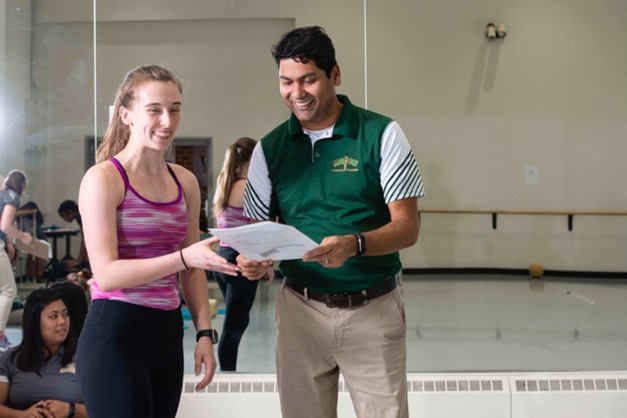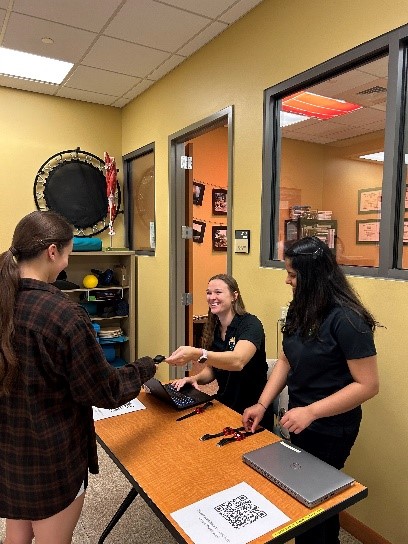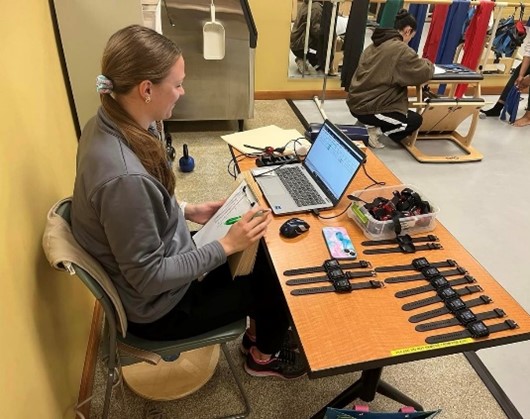Mason Researchers Study Intricate Physical and Mental Demands on Collegiate Dancers
December 7, 2023
Researchers at George Mason University’s College of Education and Human Development (CEHD) are studying the intricate world of collegiate dance as they try to develop a better understanding of the physical and mental demands placed on dance majors. The research team is led by Jatin Ambegaonkar, associate dean for research in the CEHD Office of Research Development and professor in the Athletic Training Education program within Mason’s School of Kinesiology, and Kelley Wiese who is a PhD student at Mason pursuing her PhD in Education, Kinesiology Concentration. This study, funded by a grant from the Virginia Athletic Trainers’ Association, will allow Wiese and Ambegaonkar to call attention to the rigorous nature of this art form and how it can impact the well-being of performers. In so doing, they hope to increase awareness of the health needs of collegiate dancers.
Commenting on the award, Wiese stated, “We are very grateful for the support from the Virginia Athletic Trainers’ Association. This aid allows us to highlight and support the intense demands of these deserving aesthetic athletes and truly make a difference for collegiate dancers.” Wiese herself has a deep-rooted connection to the world of performance. “As I grew up as a dancer and performer,” she explained, “I've been passionate about performing arts my entire life,” She added that this intimate understanding, cultivated through her personal experiences on stage, provides her with a unique insight into the physical and psychological demands of artists during training, rehearsals, and recovery.


Jatin Ambegaonkar, professor in Mason's School of Kinesiology, is leading a research team that is studying the physical and mental demands placed on collegiate dancers.
Photos by Evan Cantwell/Creative Services/George Mason University
While dance offers physical and psychosocial benefits to an estimated 11 million participants in the U.S., an alarming 85% suffer injuries annually, thus underscoring the vital need for specialized care. Offering her observations on this finding, Wiese stated, “My personal passion for performing arts aligned with the desire to provide quality care for performers.” She emphasized that it was this alignment that led to her interest in research on performing arts medicine and her desire to call attention to the intense demands placed on these deserving aesthetic athletes.
The study conducted by Wiese and Ambegaonkar will include: 1) an assessment of the physical activity demands and sleep quality among collegiate dance majors as measured by data collected from innovative and state-of-the-art, wearable biosensors; and 2) an analysis of self-reported perceptions involving physical and mental workload, fatigue, and sleep within the same demographic. Researchers believe that an assessment of the sleep habits and workload endured by these performers will elucidate the complexities of the physical and mental strains experienced by collegiate dancers and provide information that is crucial for clinicians, educators, dance programs, and the dancers themselves.
Elaborating on the team’s goals for the study, Ambegaonkar stated, “We focus on holistic aspects like sleep, nutrition, fitness, and health literacy. Our mission is injury prevention and performance enhancement, extending dancers’ careers. We anticipate that the findings of this research will demonstrate the physical and mental workload and sleep habits of collegiate dancers. These insights will enable stakeholders to tailor training, recovery, and participation considerations to accommodate the fluctuating demands experienced throughout the year.”



Cutting-edge biosensors are being used in the study to measure physical and mental workload, fatigue, and sleep quality in collegiate dance majors.
Ambegaonkar pointed out that the study will illustrate the indispensable role of on-site access to qualified healthcare professionals who are dedicated to monitoring and supporting the unique needs of this specialized group of aesthetic athletes. He added that by raising awareness about the necessity of tailored healthcare support for dancers, this research will help foster an environment conducive to their holistic well-being.
For Ambegaonkar, his lead role in the current study is representative of the dedication and commitment he has exhibited throughout his career in seeking to expand the body of scientific knowledge pertaining to dancers’ risk of injury—a mission he embarked on when he first started working at Mason in 2006. His ethos of “Health for Dancers, Dance for Health,” gave rise to an initiative known as Supporting Healthy Arts Research (SHARe), a pioneering consortium established in 2018 that spans multiple institutions aimed at holistically addressing dancers’ health needs.
Ambegaonkar declares emphatically, “Dance medicine is my greatest passion.” To this end, he believes that this area of research holds the promise to unlock crucial insights that could significantly impact the training, recovery, and overall care provided to collegiate dancers and which could lead to enhanced support and understanding within the realm of performing arts.
For more information, please visit Mason’s School of Kinesiology website.
